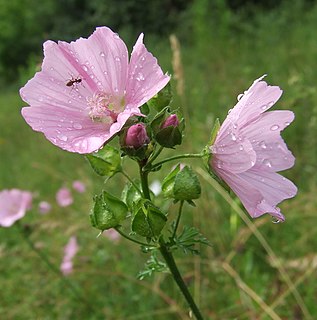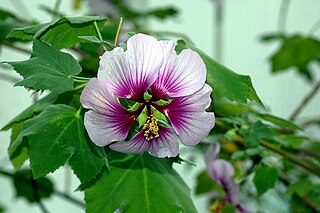
Lavatera is a genus of about 25 species of flowering plants in the family Malvaceae, native to the Mediterranean region, central and eastern Asia, North America and Australia. A number of species are naturalized in North America.

Malva pudding is a sweet pudding of South African origin. It contains apricot jam and has a spongy caramelized texture. A cream sauce is often poured over it while it is hot, and it is usually served hot with custard and/or ice-cream. Many South African restaurants offer it.
M. sylvestris may refer to:
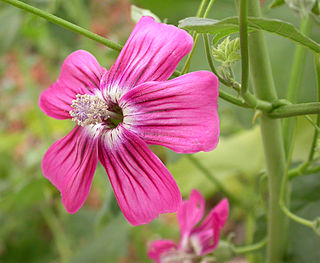
Lavatera assurgentiflora – now classified as Malva assurgentiflora, the island mallow, mission mallow, royal mallow, island tree mallow, malva rosa, is a species of flowering plant in the mallow family.

Malva arborea, the tree mallow, is a species of mallow native to the coasts of western Europe and the Mediterranean region, from the British Isles south to Algeria and Libya, and east to Greece.

Malva sylvestris is a species of the mallow genus Malva in the family of Malvaceae and is considered to be the type species for the genus. Known as common mallow to English-speaking Europeans,
it acquired the common names of cheeses, high mallow and tall mallow
as it migrated from its native home in Western Europe, North Africa and Asia through the English-speaking world.

Malva neglecta is an annual growing to 0.6 m (2 ft). It is also known as common mallow in the United States and also buttonweed, cheeseplant, cheeseweed, dwarf mallow and roundleaf mallow.
This plant is often consumed as a food, with its leaves, stalks and seed all being considered edible. This is especially true of the seeds, which contain 21% protein and 15.2% fat.
Common mallow is a common name used for a number of different species of Malva:

Malva parviflora is an annual or perennial herb that is native to Northern Africa, Europe and Asia and is widely naturalised elsewhere. Common names include cheeseweed, cheeseweed mallow, Egyptian mallow, least mallow, little mallow, mallow, marshmallow, small-flowered mallow, small-flowered marshmallow and smallflower mallow.
M. parviflora leaf extracts possess anti-inflammatory and antioxidant activities.
It has a decumbent or erect habit, growing up to 50 cm in height. The broad leaves have 5 to 7 lobes and are 8 to 10 cm in diameter. It has small white or pink flowers with 4 to 6 mm long petals.

Lavatera cretica is a species of flowering plant in the mallow family known by the common names Cornish mallow and Cretan hollyhock. It is native to western Europe, North Africa, and the Mediterranean Basin, and it is naturalized in areas with a Mediterranean climate, such as parts of Australia and California. This is an annual or biennial herb growing a tough, somewhat hairy stem to a maximum height between 1 and 3 meters. The leaves are multilobed with flat or wavy edges, slightly hairy, and up to 10 centimeters long. The plant bears small pink or light purple flowers with petals just over a centimeter long. The fruit is disc-shaped with 7 to 10 segments.

Carcharodus alceae, the mallow skipper, is a butterfly of the family Hesperiidae. The scientific Latin species name alceae refers to the host plants Althaea, which, in turn, are named after the ancient Greek poet Alcaeus of Mytilene.
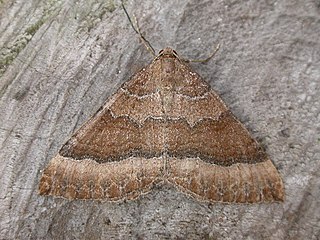
Larentia clavaria, the mallow, is a moth of the family Geometridae. It is found in Siberia in the East to the Iberian Peninsula, North Africa, and the British Isles in the West, across South, Central and Eastern Europe. In the North it ranges to the Caucasus and Tajikistan and Fennoscandia. In the South it is found the Western Mediterranean islands, Italy, the Balkans and Asia minor. It occurs only locally and is almost always rare. In the Alps, it rises up to 1200 m above sea level.
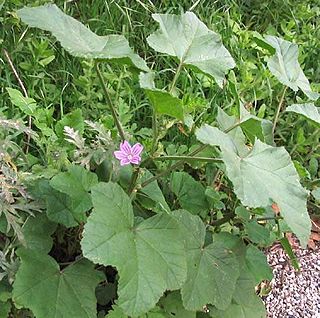
Malva nicaeensis is a species of flowering plant in the mallow family known by the common names bull mallow and French mallow.

Malva verticillata, also known as the Chinese mallow or cluster mallow, is a species of the mallow genus Malva in the family of Malvaceae found in East Asia. M. verticillata is an annual or biennial that grow up to 1.7 meters in high and can inhabit woodland areas of different soil types. In temperate climates, it flowers from July to September and the seeds from August to October. The flowers of the plant are self-fertile but can also be pollinated by insects.

Malva pusilla, also known as Malva rotundifolia, the low mallow, small mallow, or the round-leaved mallow, is an annual and biennial herb species of the Mallow genus Malva in the family of Malvaceae. Malva is a genus that consists of about 30 species of plants. This genus consists of plants named mallows. Mallows grow in many regions, including temperate, subtropical, and tropical areas.
(Persian: خبّازی، پنیرک)


